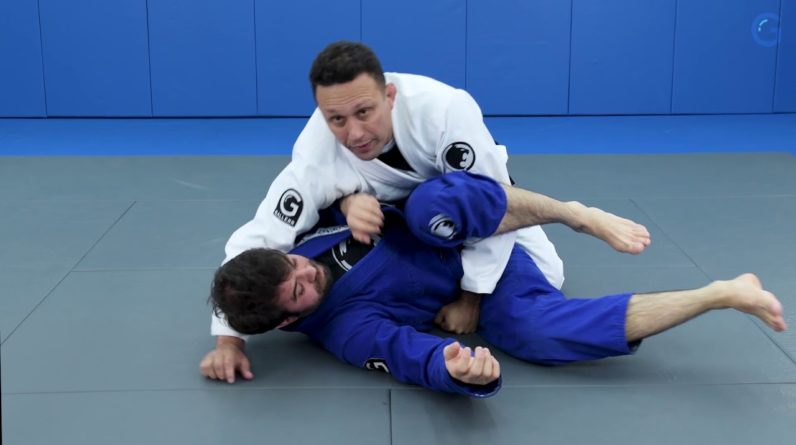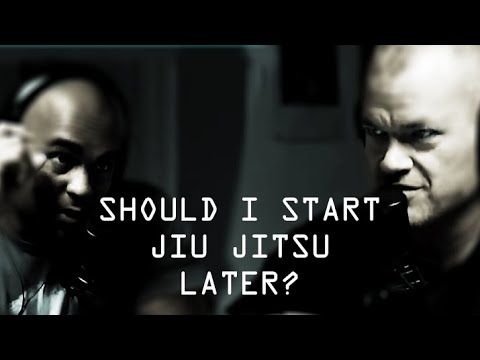I can interact with you and answer your questions which I imagine many others that have been watching on-line will have. We'll start with this quick transmission but actually I'll be giving you the class, we'll probably have some Iive interactions from people at home but I'll be able to take questions and answer any questions you have and I'll try and give you a broader vision about Jiu Jitsu gym management and about the market Hi Guys, good evening welcome to my first live broadcast of "Life off Jiu Jitsu." about gym management for Jiu Jitsu.
I'm really happy to see you all here and for people watching at home who will be able to ask questions during the class. I wanted to start this class with a pertinent question, how should we treat our student? Should we treat our student like a disciple or like a client? If we look at the 1990's when the majority of teachers were active they were brought up in a really competitive environment where competition mattered, where being a follower of your master mattered. Obviously, if you had this as a student, it's natural to replicate this pattern as a teacher so what happens in most academies? is we see the second option. The student is a disciple, If the student doesn't do what the master would like or if he leaves to try and find a better service he'll be called a "traitor" part of what Jiu Jitsu still sees today. Maybe it's the most serious thing a Jiu Jitsu teacher can do today which is to try and control their students but without giving good service.
If we have a slightly different understanding and treat our student like a client how does this work in practice? I have to give better service if I don't give him a better service, he'll just look for a different gym next to me and he has every right to do this. If I treat my student like a disciple I have to think of him like my property and that he'll do everything I say. This attitude really came about from that era of competition and it was when the academies in the 90's started to shrink. It was actually a really difficult time for Jiu Jitsu despite its growth what happened in the decade of the 90s? Vale tudo in 1991 – Jiu Jitsu against Luta Livre which was the beginning of the explosion of Jiu Jitsu in Brazil it was televised on the channel Globo, and the academies in Rio de Janeiro started to fill up which was then still the epicentre.
After 1993, it was the launch of UFC and after that everyone wanted to do Jiu Jitsu and this fever spread throughout the world this all happened in the decade of the 90's as well. The Brazilian Federation: CBJJ was also founded in the 90s. and soon after the International Federation IBJJF In 1996, the first world champion competitions happened. Everything that we're talking about here are the main competitive events. Jiu Jitsu returned completely to this focus of competition. It was very cool the evolution of the competitive side of the sport was something evident and beneficial up to a certain point.
However, the other side was forgotten. Just to give you a number so you can think about this, the first Gracie academy in the 1950s, of Master Carlos and Helio Gracie in the centre of Rio de Janeiro had 600 private students. Who wouldn't love that! I would have loved that! Why? Because the culture then wasn't about competitions the culture was about dispersing a service to the community, for people who wanted to learn self-defence, feel safer, to be in a healthy environment they would go to the Gracie academy and learn there, a self-defence program. We'll talk about this a little more when we talk about the importance of the methodology. What happened? With time these private students that trained within a private class program started to get better and better which forced the teachers to train better and more effectively with them. Imagine if you had 600 students five tatami areas and the whole Gracie family working there giving classes so a teacher could easier give 8-10 classes a day classes that lasted 30 minutes at that time.
Imagine a teacher giving 10 classes training with students 10 times he would have been exhausted training 10 students in the same day. The family started to invite these students to do the evening training which was just the family training it was just family that trained in that environment there, they gave private classes and trained together for their own personal and technical evolution. The tougher students joined that group from there, came the first collective group training within Jiu Jitsu only there wasn't any methodology it was just people coming together to train like an "open mat." It was basically, a warm-up, someone would show maybe 2 techniques that was the training. Is this familiar to what you're used to? warm-up, 2 techniques, training… that was the structure of group training when Jiu Jitsu started to spread who gives classes now, is the guy who had that experience it was the student that was good, and also wanted to teach so he left the academy to give classes in another academy taking with him that model of class.
When various people started doing this, it created a competitive environment meaning that all the academies started focusing on competition and it happened more and more until it peaked in the decade of the 90s. The reason why it's necessary to have this conversation is so you can understand where the problem came from and why we need to correct it. What happened in the 90s, meant Jiu Jitsu could only be delivered to a really small quantity of people which was who? athletes Jiu Jitsu was all about high-performance at that time the only thing that mattered for academies at that time was whether someone was a competitor or not.

Everyone trained in the same environment, together. Today I'm a little more conscious of this and I talk about it easily because I lived through that same era, everybody's academy was like this, mine included. there weren't any exceptions. I doubt even that if Master Helio Gracie could incarnate again in this life time he would be able give a good class for someone with the objective of competition — a purple belt and a white belt that's just starting in the same class, it's virtually impossible. They're completely different objectives. So, how can we start delivering Jiu Jitsu for each profile of person.
But it's this that will make your academy successful. I can't put everyone together I can't give the same class for everyone. My student needs to have a class specific to him So….our student needs to be a client. When did this become really obvious As I said before, in the decade of the 90s Jiu Jitsu was popularised by UFC — it spread around the world people wanted to know about the sport and started to contract people from here to give seminars. Seminars were a way for Jiu Jitsu to develop for countries outside of Brazil I was really happy to be considered a "highlight" in that moment I was often invited abroad and I went not just giving seminars but thinking about how I could build a network of academies how I could be invited again. Instead of doing a 2-hour seminar, I offered to stay for a week and explain how my academy works I really just replicated what I did in Brazil what was that? A training — that was tough, because that is what I was used to, competition was the focus then and that is what I showed and sold to people outside of Brazil.
Until one day, during a seminar in Germany I met a teacher of Wing Chun. Does anyone here know what Wing Chun is? you? the only person here that knows about it! Anyway, I didn't know what Wing Chun was. This teacher was a guy around 50-years-old still a white belt in Jiu Jitsu but totally besotted by Jiu Jitsu he loved it. But he thought the training was too tough, he couldn't do it. I said, "no, Jiu Jitsu is for everyone." he said, "are you crazy, there's no way it's for everyone." "It's for top athletes, I'm just here because I really like it." He asked me how Alliance worked and he asked me a question. Do you know how many Wing Chun students my master has in Germany? I didn't have an idea. I said, "1000." He told me, 50,000 students. 50,000 Wing Chun students. I thought to myself, I should have chosen Wing Chun! instead of Jiu Jitsu — I chose wrong! Anyway, out of curiosity I went to watch a Wing Chun class. I needed to see what it was all about.
But actually, I didn't really see much regarding the efficacy compared to Jiu Jitsu or even the physical part which didn't seem like the best way to keep in shape but it did have a system which showed the student exactly where he was inside the process. He knew how many classes he had to do to take a graduation exam etc he knew about his process of evolution something that Jiu Jitsu was so far away from. How did we graduate our students in Jiu Jitsu? The end of the year came. There was the end of year graduation or it was based on performance in competition.
In our academy, graduations were based much more on performance than on the graduation at the end of the year we almost never did end of year graduations. You had to have a really good performance, beating everyone in your category if not, you wouldn't get the following belt. What were we saying? That you had to be the absolute best in your academy, now imagine a normal student who had a different area of work and trained just as a hobby, how can you measure him against a professional? But this is what we based our graduations on.
It was insanity, you never knew when you would get the next belt when you eventually did, it was a real achievement, you conquered something really difficult. But how many people managed that? only a very few and Jiu Jitsu shrunk and shrunk. This is what happened to Jiu Jitsu in the decade of the 90s. I came back from that trip to Europe thinking that we were doing it all wrong. It wasn't possible that Wing Chun could have 50,000 students and the whole of Alliance had maybe 1500 students then it didn't make sense we were making a mistake in something, and it was a bad mistake. I knew what it was: we didn't have any methodology.
When I started learning Jiu Jitsu I learned the Gracie Academy program. It was a small academy, in a room maybe this size with 6 students and the teacher showing us all the details one by one it really enchanted me so I stayed there. I continued the process and I fell in love with the sport but it was that which got my attention, I said to myself, we need to start to write a method but thinking for a group rather than just thinking about private classes because there was already a program for individual classes. Individual classes however don't work for collective classes think of it like this, I'll teach class 1: Introduction to Jiu Jitsu.







